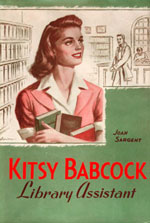jenw.org:  "From girl detective stories to novels about boy wizards, series fiction has long been a staple of young adult literature. One type of series less well-known today is the "career romance" or 'career girl novel' that appeared during the 1940s through the 1960s, as women entered the workplace in increasing numbers. Publishers of juvenile fiction sought to exploit this demographic trend with books featuring accomplished and attractive young women simultaneously pursuing their professional and romantic goals.
"From girl detective stories to novels about boy wizards, series fiction has long been a staple of young adult literature. One type of series less well-known today is the "career romance" or 'career girl novel' that appeared during the 1940s through the 1960s, as women entered the workplace in increasing numbers. Publishers of juvenile fiction sought to exploit this demographic trend with books featuring accomplished and attractive young women simultaneously pursuing their professional and romantic goals.
Although Nancy Drew is still sleuthing over 70 years on, her one-time fictional contemporary found herself retired from the shelves once the novelty of women in the workforce wore off. Today one needs an eBay buyer's account or access to a library with a historic children's literature collection (or an inadequate weeding policy) to find career-girl titles like Joan Chooses Occupational Therapy (1944) or Brenda Becomes a Buyer (1960). Out-of-print series such as Dodd Mead's 'Career Books' or J. Messner's 'Career Romances for Young Moderns' present a broad range of job scenarios, including the pioneering (Lady Architect [1957]; Lady Doctor [1964]; Lady Lawyer [1964]) and the unusual Sandra Kendall of the 4-H: The Career Story of a Young Home Demonstration Agent [1942]; Tune in for Elizabeth: Career Story of a Radio Interviewer [1945]; Space Secretary [1963]). However, most titles explore more commonplace, female-dominated professions such as nursing, teaching, and library science. "
 "From girl detective stories to novels about boy wizards, series fiction has long been a staple of young adult literature. One type of series less well-known today is the "career romance" or 'career girl novel' that appeared during the 1940s through the 1960s, as women entered the workplace in increasing numbers. Publishers of juvenile fiction sought to exploit this demographic trend with books featuring accomplished and attractive young women simultaneously pursuing their professional and romantic goals.
"From girl detective stories to novels about boy wizards, series fiction has long been a staple of young adult literature. One type of series less well-known today is the "career romance" or 'career girl novel' that appeared during the 1940s through the 1960s, as women entered the workplace in increasing numbers. Publishers of juvenile fiction sought to exploit this demographic trend with books featuring accomplished and attractive young women simultaneously pursuing their professional and romantic goals.
Although Nancy Drew is still sleuthing over 70 years on, her one-time fictional contemporary found herself retired from the shelves once the novelty of women in the workforce wore off. Today one needs an eBay buyer's account or access to a library with a historic children's literature collection (or an inadequate weeding policy) to find career-girl titles like Joan Chooses Occupational Therapy (1944) or Brenda Becomes a Buyer (1960). Out-of-print series such as Dodd Mead's 'Career Books' or J. Messner's 'Career Romances for Young Moderns' present a broad range of job scenarios, including the pioneering (Lady Architect [1957]; Lady Doctor [1964]; Lady Lawyer [1964]) and the unusual Sandra Kendall of the 4-H: The Career Story of a Young Home Demonstration Agent [1942]; Tune in for Elizabeth: Career Story of a Radio Interviewer [1945]; Space Secretary [1963]). However, most titles explore more commonplace, female-dominated professions such as nursing, teaching, and library science. "
Comments
SSR Movies